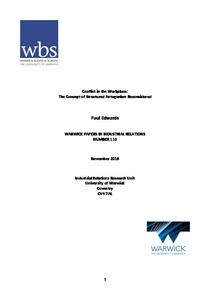Conflict in the workplace: the concept of structured antagonism reconsidered
"The concept of a ‘structured antagonism’ in the workplace, introduced in 1986, is revisited and extended. Part of the revisiting clears up misunderstandings about the idea which have arisen as a result of its being cited without always being fully understood. The core idea, that the SA exists...
| Main Author: | |
|---|---|
| Institution: | ETUI-European Trade Union Institute |
| Format: | TEXT |
| Language: | English |
| Published: |
Coventry
2018
University of Warwick |
| Subjects: | |
| Online Access: | https://www.labourline.org/KENTIKA-19306330124911245129-Conflict-in-the-workplace-the-.htm |
| Summary: | "The concept of a ‘structured antagonism’ in the workplace, introduced in 1986, is revisited and extended. Part of the revisiting clears up misunderstandings about the idea which have arisen as a result of its being cited without always being fully understood. The core idea, that the SA exists because exploitation is inscribed in the organization of work, is defended. There are none the less weaknesses in the initial formulation. In particular, [1] it relied too heavily on the idea that only the direct producers of goods and service produce what has value, namely, the product; and [2] it did not sufficiently ground activity at the point of production in structures of ownership and control. In relation to [1], production also entails co-ordination and planning, and those engaging in such activities are productive. In relation to [2], though co-ordination and planning are productive, exploitation continues to exist because of the rights of control that ownership gives to capitalists. A research implication is the need to examine the links between directly productive labour and the activities of co-ordination and planning." |
|---|---|
| Physical Description: | 22 p. Digital |

